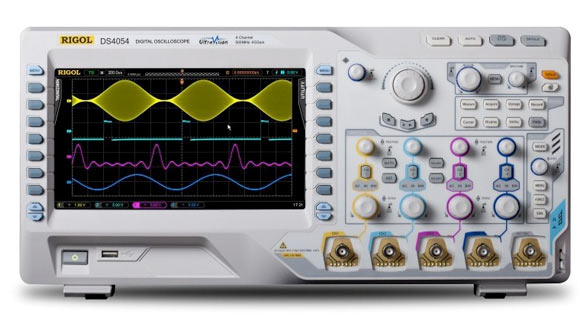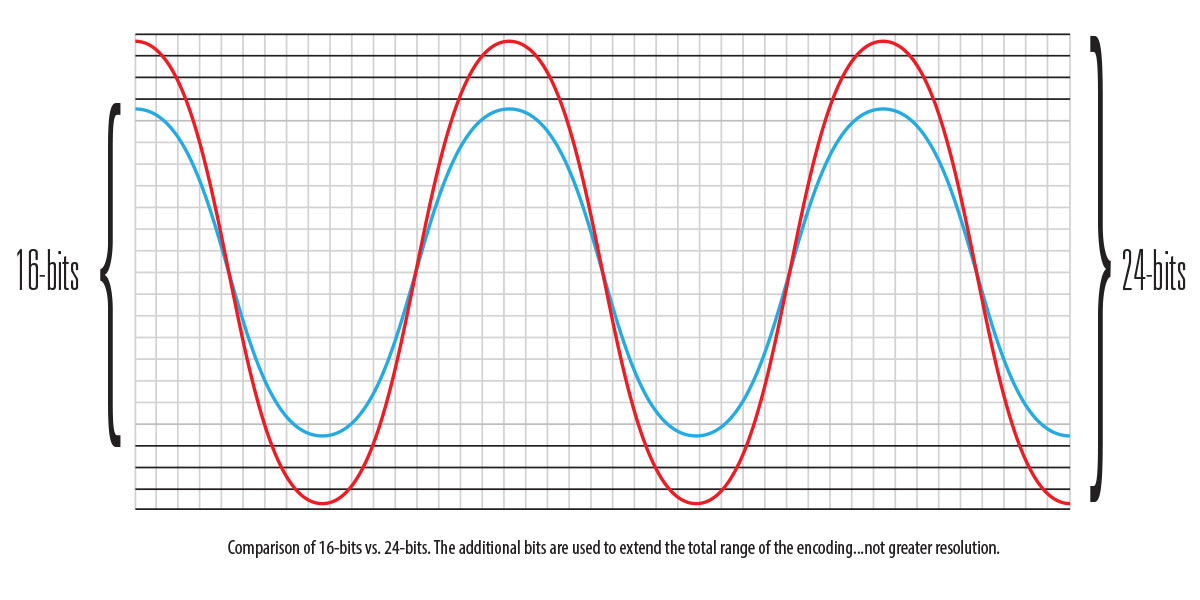16 vs. 24 Bits
Here’s a quote from a popular online audiophile site, “In PCM audio, it is felt by many that the bit rate is more important than the sample rate as the greatly increased number of numerical values means more resolution to resolve the intricate details in the music.”
The piece was supposed to be a technical explanation about the difference between standard 16-bit resolution and high-definition PCM recordings at 24-bits. But the writer had the wrong idea of what the 8 additional bits mean in terms of recording fidelity. The world of “computer audio” is challenging enough without amateurs providing technical information that is not correct. And you would think that the editors of the online publication would have someone on staff that could validate the statements published on their site. This sort of incorrect information can be expected on a forum but not as a feature article in a prominent online site…especially one that doesn’t provide for any comment to point out errors.
There are two key sub phrases in that statement that are wrong. The first is that “the greatly increased number of numerical values means more resolution to resolve the intricate details in the music.” This is absolutely false, as we’ll see below.
The second one is that there is no such thing as “bit rate” as applied to amplitude levels in a PCM encoding system. The use of the word “rate” would apply to things that have a frequency…like sample rate or turnover rate. Bits don’t have frequency! They are gathered together in words (of varying lengths of perhaps 8, 16 or 24) and distributed along the vertical axis of the PCM “battleship” grid. I believe what the author was trying to convey is the concept of “word length”, which is how audio engineers and digital circuit designers refer to it. At each sample point, what is the 16-bit or 24-bit value that best identifies the amplitude of the analog waveform?
I tackled the issue of 24-bits being valid over 16-bits in a post a few weeks ago (you can revisit that post here Click Here), but I think a post with greater focus on what it means to record using 24-bits might shed more light on the notion.
The author did mange to get the math right with regards to the number of levels that can be accurately described with 16 or 24 bits. There are 65,536 values for 16-bits and 16,777,216 values for 24-bits. So the real question is what happens when you have more bits? In the simplest terms, engineers recording new tracks have the possibility of recording wider dynamic ranges. In a world of 16-bits or roughly 96 dB of SNR (signal to noise) ratio, there’s actually plenty of room for almost all types of music. Having an additional 8-bits, however, guarantees that ALL music
(or sounds) can be captured within the additional 48 dB of SNR that they provide. I understand these are theoretical numbers but the point is that you don’t get “more resolution” within the existing dynamic range. The article has it dead wrong.
Audio signals have amplitude that varies periodically in time. These are the so-called waves that we see on the screens of oscilloscopes or newer computer systems. See the figure below.
Figure 1 – An illustration showing that 24-bits gives you a wider range of loudness possibilities NOT more resolution within the same 16-bit range.
I know the diagram isn’t showing the correct number of levels for 16 vs. 24 bits (drawing 65K lines or more would be impossible)…but it does show the additional range of 24 bits. That’s the point. The notion that the, “increased number of numerical values means more resolution to resolve the intricate details in the music” comes from someone that needs to continue looking into the subject.
The red sine wave could not be recorded within the 16-bit portion of the amplitude grid without the input to the ADC being turned down or a compressor applied. If the ADC was a 24-bit unit, then the red trace could be completely and accurately captured.
Using 24-bits makes sense because it encompasses all possible amplitude values that an engineer is likely to encounter during a session AND it means that consumers can receive recordings that weren’t compressed in any way. It’s a win-win.



Hi, great article,I have been researching this for a number of years now, and it still amazes me when I hear industry professionals waxing lyrical about the extra resolution and “space” the 24bit brings, obviously having no understanding of how it works, it would be great if 24 bit meant higher dynamic range in the final product, but unfortunately, mainstream music mastering compresses the dynamics out of the music before it even gets to a consumer format. I was into hi res audio for a while, until I realized that my original release CD’s sounded better than the DVD-A or SACD versions I had of those same albums because mastering engineers had clipped all of the dynamics out and increased the gain to 0dbfs, rendering any extra supposed benefit of hi res audio null and void, at that point I sold all my hi res audio gear and discs and went back to CD and vinyl. ever since I have been seeking out original 80’s and early 90’s release CD’s of older albums that had dynamics and life and have never been happier!
But there are some (admittedly not many) REAL HD-Audio recordings out there that aren’t mastered heavily. My own stuff, for example.
Pingback: What mastering involves - Page 2